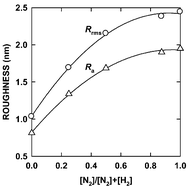Amorphous hydrogenated silicon carbonitride films were produced by remote plasma chemical vapor deposition (RP-CVD) from 1,1,3,3-tetramethyldisilazane (TMDSN) as the single-source compound using a H2–N2 upstream-gas-mixture for plasma generation. The reactivity of particular TMDSN bonds in the RP-CVD initiation step has been examined using a hexamethyldisilazane model compound in the deposition experiments. The active species contributing to RP-CVD were identified by optical emission spectroscopic analysis of the plasma region. The films were examined using Fourier transform infrared spectroscopy, X-ray photoelectron spectroscopy, and atomic force microscopy. The effect of N2 content in the H2–N2 upstream-gas-mixture on plasma generation of the active species, growth rate, chemical structure, and surface morphology of the resulting films is reported.
You have access to this article
 Please wait while we load your content...
Something went wrong. Try again?
Please wait while we load your content...
Something went wrong. Try again?


 Please wait while we load your content...
Please wait while we load your content...